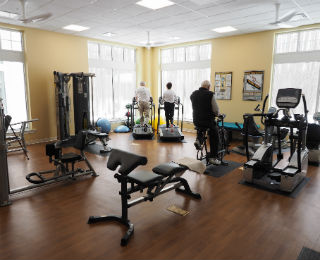Published: September 3, 2015

Written By: Molly Kavanaugh
Keeping physically active as you age is key to maintaining an independent lifestyle, warding off aches and enhancing emotional well being. Just ask Ann Francis, who enlisted the assistance of a personal trainer soon after she arrived at Kendal at Oberlin.
“I wanted to get started on a balance program so we went through all the equipment. Now I have a workout plan that takes me 20 to 45 minutes,” says Ann, who bikes, walks her dog at least a mile daily and participates in strength building and Tai Chi classes.
“I think exercise is not only key to physical health but it’s key to mental health. It makes me happier,” the 72-year-old woman says.
Kendal’s New Equipment Room
Kendal recently completed construction of a new exercise equipment room, which includes a Smith machine that allows a person to safely lift weights without a spotter.
Resident John Leinenweber, an avid participant in swimming and balance classes, has now added the Smith machine to his workout.
“I’m not much of a machine person, but I’d like to build up my upper body,” he says.
Muscle loss is one of the biggest challenges we face as we age. According to National Public Radio, those over the age of 60 can lose about two pounds of muscle every five years; an average male who weighs 180 pounds may lose as much as 10 pounds of muscle mass over a decade.
But muscle loss isn’t inevitable. In fact, older adults who perform resistance exercises, like weight lifting, can not only reverse age-related muscle loss, but actually build new muscle, too.
An ideal way for older adults with sedentary lifestyles to begin a weight lifting regimen is by simply getting in and out of their chairs 10 or more times. According to NPR, “using one’s own body mass as a dead weight is a ‘reasonable way to start’ [weight lifting].”
Benefits of Physical Activity
The benefits of physical activity are numerous. Exercisers have fewer falls and fractures and more stamina and strength, according to the Centers for Disease Control and Prevention. And physical activity does not need to be strenuous to achieve health benefits.
Older adults with arthritic pain often find relief engaging in aquatic therapy programs. Three times a week Kendal resident Pauline Freas participates in a water aerobic class, then relaxes for about 10 minutes in the 95-degree therapy pool.
“I think it’s a wonderful program,” says Pauline, who hopes the regular exercise will avert surgery for back and shoulder pain.
All About Tai Chi
Meditation, yoga and tai chi appeal to men and women looking for a more holistic activity.
“Tai Chi is repetitive but it can be somewhat challenging to learn,” says Kendal Wellness Coordinator Jill Connone. “Once you have the muscle memory down it is time to start on the meditation part of it.”
Tai Chi calms your mind and centers your energy, and helps relieve built up tension and stress. There are also physical benefits of the practice. All the movements are designed to improve the flow of chi—or energy—in the body.
“The two main aspects of Tai Chi that are brought out are balance and coordination, plus strength because you are moving very slowly,” Connone says. “Most of those in my class have felt that the largest improvement is in their balance since they are moving slowly and shifting weight.”
For those who like to exercise in groups, physical activity can have an additional benefit: increased socialization. Organized programs like group exercise classes give older adults the opportunity to socialize with other people of similar age or skill sets and can be rewarding and motivating, says Deborah Redder, a national fitness program director for SilverSneakers.
And just a small amount of exercise may improve your ability to think, according to a study by the University of Kansas Alzheimer’s Disease Center, published in the New York Times.
The researchers recruited 101 sedentary adults at least 65 years of age, who were generally healthy with no signs of cognitive impairment. They found that most of the exercisers showed improvements in their thinking skills. But the gains were about the same whether people had exercised for 75 minutes a week or 225 minutes.
 Written By: Molly Kavanaugh
Written By: Molly Kavanaugh





